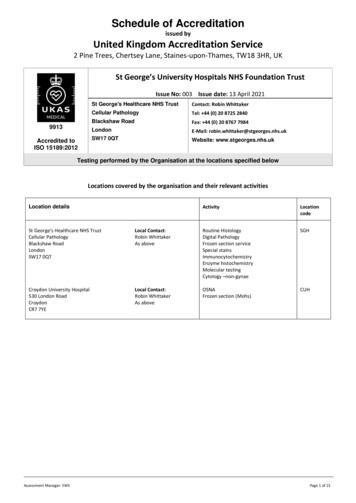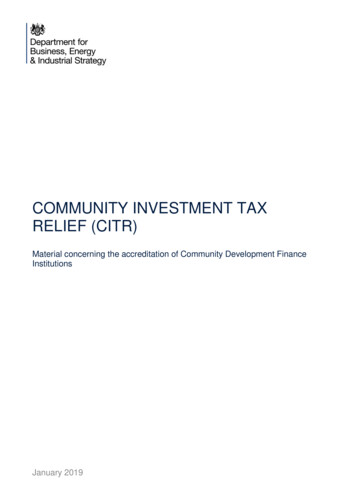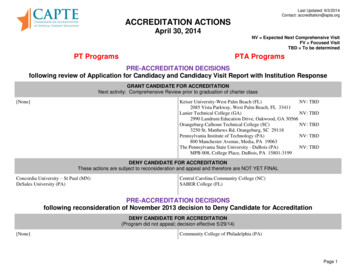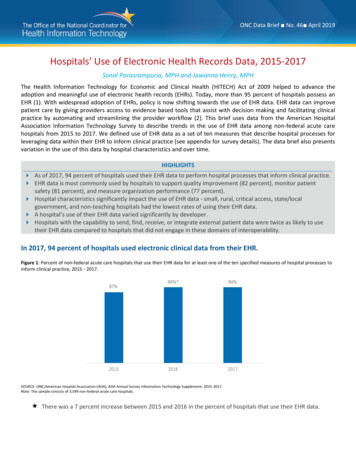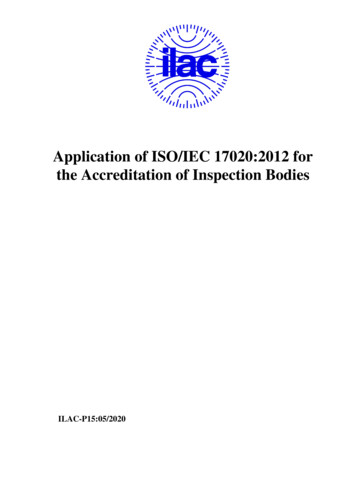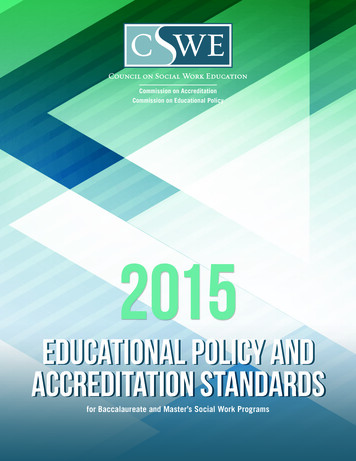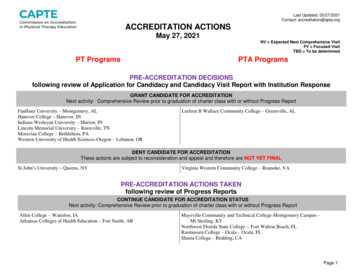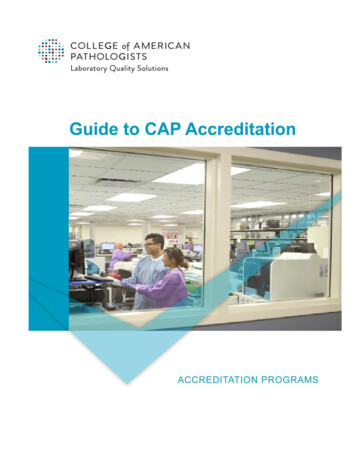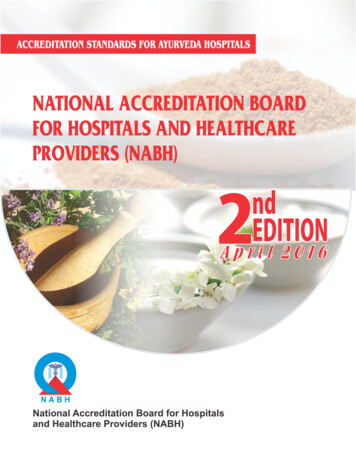
Transcription
National Accreditation Boardfor Hospitals and HealthcareProviders (NABH)Accreditation Standards for AyurvedaHospitals2nd EditionApril 2016 National Accreditation Board for Hospitals and Healthcare Providersi
All Rights Reserved.No part of these publications may be reproduced in any form without the priorpermission in writing from the author.2nd Edition April 2016 National Accreditation Board for Hospitals and Healthcare Providersii
National Accreditation Board for Hospitals and Healthcare Providersiii
National Accreditation Board for Hospitals and Healthcare Providersiv
INTRODUCTIONThe first edition of NABH standard has been in practice for last six years now (2009-15) andis revised and up-graded to 2nd edition. The guiding principles for revision of the standardshave mainly been the experience of stake holders including assessors, hospitals, membersof accreditation and technical committees and industry experts. Before finalization of these,public opinion was also sought. Secretariat of NABH did bulk of job by collating andassimilating the feedback information, linking with relevant chapters and presenting to thetechnical committee for deliberations. This was again discussed in detail by industry experts.It was finally and extensively reviewed by Committee appointed by Ministry of AYUSH, whichwent in to thought process and came out with the edition, which is now in your hands.The accreditation standards are not expected to be prescriptive. They only lay down therequirements and it is up to the healthcare organizations to come out with the systems,processes and modes of measuring performance indicators, which can demonstratecompliance to the requirements as specified in the standard. NABH has tried its best to beas objective and pragmatic as possible.There can be more than one way, by which an Ayurveda healthcare organisation can complywith the requirements of the standards. Three books are being made available for use by thestakeholdersie 2nd edition Standards book, a guidebook containing glossary and acompilation of various practices in the form of annexures, including matrix for calculatingquality indicators and other relevant material.Accreditation as we know is basically a framework which helps healthcare organizations toestablish objective systems aimed at patient safety and quality of care. Documentation playsan important role in defining such systems. Wherever there are references to documentedrequirements, it needs to be clearly understood that such documentation needs to beestablished and understood at all levels, reviewed at regular intervals, and controlled andevidenced for their effective implementation by way of records.The second edition of these standards has put more focus on clinical care aspects.Structural requirement which used to be a separate book in first edition, have beenincorporated in second edition at appropriate places. National Accreditation Board for Hospitals and Healthcare Providersv
The requirements of the standards shall have to be identified; evidenced by data gathered,analysed and interpreted with the aim of improving the quality system of a hospital.Wherever the word shall/should is used, it is imperative that the organisation implement thesame. Where the phrase can/could/preferable is used the organisation would use itsdiscretion and implement it according to the practicability of the proposed guidance.In general, the organisation will need to establish clear evidence backed by robust systemsand data collection to prove that they are complying with the intent of the standards. Thesesystems are as we say, defined, implemented, owned by the staff and finally provideobjective evidence of compliance. Some of the key issues are as follows;1.Patient related: monitoring safety, treatment standards and quality of care. Thiswould mean to effectively meet the expectation of patients and their families andassociates.2.Employee related: monitoring competence, on-going training, awareness of patientrequirements and monitoring employee satisfaction.3.Regulatory related: identifying, complying with and monitoring the effectiveimplementation of legal, statutory and regulatory requirements which affect patientsafety.4.Organisation policies related: defining, promoting awareness of and ensuringimplementation of, the policies and procedures laid down by the organisation,amongst staffs, patients and interested parties including visiting medical consultants.5.NABH Standards related: identification of how the organization meets the NABHstandards and the objective elements. Where a part of an element, an element or astandard cannot be applied (for example, related to emergency, surgical proceudres,laboratory services, radiological services, etc) in a particular organization, adequateexplanation and justification must be provided to NABH and its team of assessors toenable exclusion of applicability. In particular, it must be ensured that the intent ofeach chapter of standards is understood and applied.The 2nd edition of Ayurveda hospital accreditation standard is divided into 10 chapters, whichhave been further divided into 98 standards (as compared to 94 in first edition). Put togetherthere are 590 objective elements (as compared to 492 in first edition) incorporated withinthese standards. The increase in objective elements is to put increased emphasis on patientsafety and also to encourage healthcare organizations to pursue continuous qualityimprovements. Objective elements are required to be complied with in order to meet the National Accreditation Board for Hospitals and Healthcare Providersvi
requirement of a particular Standard. Similarly, standards are required to be complied with,in order to meet the requirement of a particular Chapter. Finally, compliance with all chaptersis equally important to establish compliance with the Accreditation Standard.The Standards shall facilitate health care organizations to deliver safe high quality care.In the beginning of each chapter, intent is given to highlight the summary of the chapter. Theintent statement provides a brief explanation of a chapter’s rationale, meaning, andsignificance. Intent statements may contain detailed expectations of the chapter that areevaluated in the on-site assessment process. For most of the objective elements,interpretation is provided in a separate book just to further elaborate on how that objectiveelement can be met.We are thankful to chairman & members of Technical Committee who have put great effortsto accomplish this task. These standards are equally applicable to government and privatehospitals, and are applicable to whole organisation. Standards are dynamic and would beunder constant review process. Comments and suggestions for improvement areappreciated. We seek your support in keeping these standards adequate to the need of theindustry.Dr. K.K. KalraCEO NABH National Accreditation Board for Hospitals and Healthcare Providersvii
National Accreditation Board for Hospitals and Healthcare Providersviii
TABLE OF CONTENTSS.No.ParticularPage1.Access, Assessment and Continuity of Care (AAC)1-102.Care of Patients (COP)11-233.Management of Medication (MOM)24-304.Patient Rights and Education (PRE)31-365.Hospital Infection Control (HIC)37-436.Continuous Quality Improvement (CQI)44-507.Responsibilities of Management (ROM)51-568.Facility Management and Safety (FMS)57-639.Human Resource Management (HRM)64-7110.Information Management System (IMS)72-77 National Accreditation Board for Hospitals and Healthcare Providersix
National Accreditation Board for Hospitals and Healthcare Providersx
Access Assessment and Continuity of Care (AAC)Chapter 1Access Assessment and Continuity of Care(AAC)Intent of the chapter:Patients are well informed of the services that an organization can and cannot provide.This will facilitate in appropriately matching patients with the organization's resources.Only those patients who can be cared for by the organization are admitted tothe organization. Out-patients who do not match the organization's resources aresimilarly referred to organizations that have the matching resources.Patients that match the organizations resources are admitted using a defined processthat includes patient and family education.Patients cared for by the organization undergo an established initial assessment andperiodic and regular reassessments.Assessments may include laboratory and imaging services. The laboratory andimaging services are provided by competent staff in a safe environment forboth patients and staff.These assessments result in formulation of a definite care plan.Patient care is multidisciplinary in nature and encourages continuity of care through welldefined transfer and discharge protocols. These protocols include transfer of adequateinformation with the patient. National Accreditation Board for Hospitals and Healthcare Providers1
Access Assessment and Continuity of Care (AAC)Summary of StandardsAAC.1.The organisation defines and displays the services that it provides.AAC.2.The organisation has a well-defined registration and admissionprocess.AAC.3.There is an appropriate mechanism for transfer or referral of patientswho do not match the organizational resources.AAC.4.Patients cared for by the organisation undergo an established initialassessment.AAC.5.All patients cared for by the organisation undergo a regularreassessment.AAC.6.Laboratory services, if applicable are provided as per the scope ofservices of the organisation.AAC.7.There is an established laboratory quality assurance programme.AAC.8.There is an established laboratory-safety programme.AAC.9.Imaging services, if applicable are provided as per the scope ofservices of the organization.AAC.10.There is an established quality assurance programme for imagingservices.AAC.11.There is an established radiation safety programme.AAC.12.Patient care is continuous and multidisciplinary in nature.AAC.13.The organization has a documented discharge process.AAC.14.Organization defines the content of the discharge summary. National Accreditation Board for Hospitals and Healthcare Providers2
Access Assessment and Continuity of Care (AAC)Standards and Objective ElementsStandardAAC.1.The organisation defines and displays the services that it provides.Objective Elementsa.The services being provided are clearly defined and are in consonance with theneeds of the community.b.The defined services are prominently displayed.c.The staff is oriented to these services.StandardAAC.2.The organisation has a well-defined registration and admissionprocess.Objective Elementsa.Documented policies and procedures are used for registering and admittingpatients.b.The Documented policies and procedures address out-patients, in-patients andemergency patients.c.A unique identification number is generated at the end of registration.d.Patients are accepted only if the organisation can provide the required service.e.The Documented policies and procedures also address managing patients duringnon-availability of beds.f.The staff is aware of these processes.g.Maintenance of separate daily record of bed occupancy with monthly conclusion ofoccupancy. National Accreditation Board for Hospitals and Healthcare Providers3
Access Assessment and Continuity of Care (AAC)StandardAAC.3.There is an appropriate mechanism for transfer or referral ofpatients who do not match the organizational resources.Objective Elementsa.Documented policies and procedures guide the transfer of patients to anotherfacility in an appropriate manner.b.Documented policies and procedures guide the transfer of stable/unstable patientsto another facility in an appropriate manner.c.Procedures identify staff responsible during transfer/referral.d.The organisation gives a summary of patient’s condition and the treatment given.StandardAAC.4.Patients cared for by the organisation undergo an establishedinitial assessment.Objective Elementsa.The organisation defines and documents the content of the initial assessment forthe out–patients, in-patients and emergency patients.b.The organisation determines who can perform the initial assessment.c.The organisation defines the time frame within which the initial assessment iscompleted based on patient needs.d.The initial assessment for in-patients is documented within 24 hours or earlier asper the patient’s condition or hospital policy. Initial assessment includesidentification of medication that the in-patient is using of the relevant AYUSHsystem, of any other AYUSH system and of modern medicine.e.Initial assessment includes screening for nutritional needs.f.Care plan has to be documented and is monitored after the initial assessment. National Accreditation Board for Hospitals and Healthcare Providers4
Access Assessment and Continuity of Care (AAC)g.The care plan also includes preventive aspects of the care where appropriate.h.The care plan is countersigned by the doctor in-charge of the patient within 24hours.i.The care plan includes desired results of the treatment, care or service.StandardAAC.5.All patients cared for by the organisation undergo a regularreassessment.Objective Elementsa.All Patients are reassessed at appropriate intervals.b.Out-patients are informed of their next follow-up, where appropriate.c.For in-patients during reassessment the care plan is monitored and modified,where found necessary.d.Staff involved in direct clinical care document reassessments.e.Patients are reassessed to determine their response to treatment and to planfurther treatment or discharge.StandardAAC.6.Laboratory services, if applicable are provided as per the scope ofservices of the organisation.Objective Elementsa.Scope of the laboratory services are commensurate to the services provided bythe organization.b.Adequately qualified and trained personnel perform and/or supervise theinvestigations.c.Documented policies and procedures guide collection, identification, handling, safetransportation, processing and disposal of specimens. National Accreditation Board for Hospitals and Healthcare Providers5
Access Assessment and Continuity of Care (AAC)d.Laboratory results are available within a defined time frame.e.Critical results are intimated immediately to the personnel concerned.f.Results are reported in a standardised manner.g.Laboratory tests not available in the organisation are outsourced to organisation(s)based on their quality assurance system.StandardAAC.7.There is an established laboratory quality assurance programme.Objective Elementsa.The laboratory quality assurance programme is documented.b.The programme addresses verification and/or validation of test methods.c.The programme addresses surveillance of test results.d.The programme includes periodic calibration and maintenance of all equipment.e.The programme includes the documentation of corrective and preventive actions.StandardAAC.8.There is an established laboratory-safety programme.Objective Elementsa.The laboratory-safety programme is documented.b.This programme is aligned with the organisation’s safety programme.c.Written procedures guide the handling and disposal of infectious and hazardousmaterials.d.Laboratory personnel are appropriately trained in safe practices.e.Laboratory personnel are provided with appropriate safety equipment/devices. National Accreditation Board for Hospitals and Healthcare Providers6
Access Assessment and Continuity of Care (AAC)StandardAAC.9.Imaging services, if applicable are provided as per the scope ofservices of the organization.Objective Elementsa.Imaging services comply with legal and other requirements.b.Scope of the imaging services is commensurate to the services provided by theorganisation.c.The infrastructure (physical and manpower) is adequate to provide for its definedscope of services.d.Adequately qualified and trained personnel perform, supervise and interpret theinvestigations.e.Documented policies and procedures guide identification and safe transportationof patients to imaging services.f.Imaging results are available within a defined time frame.g.Critical results are intimated immediately to the personnel concerned.h.Results are reported in a standardized manner.i.Imaging tests not available in the organization are outsourced to organization(s)based on their quality assurance system.StandardAAC.10.There is an established quality assurance programme for imagingservices.Objective Elementsa.The quality assurance programme for imaging services is documented.b.The programme addresses verification and/or validation of imaging methods. National Accreditation Board for Hospitals and Healthcare Providers7
Access Assessment and Continuity of Care (AAC)c.The programme addresses surveillance of imaging results.d.The programme includes periodic calibration and maintenance of all equipment.e.The programme includes the documentation of corrective and preventive actions.StandardAAC.11.There is an established radiation safety programme.Objective Elementsa.The radiation-safety programme is documented.b.This programme is integrated with the organization’s safety programme.c.Handling, usage and disposal of radio-active and hazardous materials are as perstatutory requirements.d.Imaging personnel are provided with appropriate radiation safety devices.e.Radiation-safety devices are periodically tested and results documented.f.Imaging personnel are trained in radiation-safety measures.g.Imaging signage are prominently displayed in all appropriate locations.StandardAAC.12.Patient care is continuous and multidisciplinary in nature.Objective Elementsa.During all phases of care, there is a qualified individual designated as responsiblefor the patient’s care.b.Care of patients is coordinated in all care settings within the organization.c.Information about the patient’s care and response to treatment is shared amongmedical, nursing and other care-providers.d.Information is exchanged and documented during each staffing shift, between National Accreditation Board for Hospitals and Healthcare Providers8
Access Assessment and Continuity of Care (AAC)shifts, and during transfers between units/departments.e.The patient’s record(s) is available to the authorized care-providers to facilitate theexchange of information.f.Documented policies and procedures guide the referral of patients to otherdepartments/ specialties.StandardAAC.13.The organization has a documented discharge process.Objective Elementsa.The patient’s discharge process is planned in consultation with the patient and/orfamily.b.Documented policies and procedures exist for coordination of various departmentsand agencies involved in the discharge process (including medico-legal andabsconded cases).c.Documented policies and procedures are in place for patients leaving againstmedical advice (LAMA) and patients being discharged on request.d.A discharge summary is given to all the patients leaving the organization (includingpatients leaving against medical advice and on request).StandardAAC.14.Organization defines the content of the discharge summary.Objective Elementsa.Discharge summary is provided to the patients at the time of discharge.b.Discharge summary contains the patient’s name, unique identification number,date of admission and date of discharge.c.Discharge summary contains the reasons for admission, significant findings anddiagnosis and the patient’s condition at the time of discharge. National Accreditation Board for Hospitals and Healthcare Providers9
Access Assessment and Continuity of Care (AAC)d.Discharge summary contains information regarding investigation results, anyprocedure performed, medication administered and other treatment given.e.Discharge summary contains follow-up advice, medication and other instructions inan understandable manner.f.Discharge summary incorporates instructions about when and how to obtainurgent care.g.In case of death, the summary of the case also includes the cause of death. National Accreditation Board for Hospitals and Healthcare Providers10
Care of Patients (COP)Chapter 2Care of Patients (COP)Intent of the standardsThe organization provides uniform care of patients in different settings. The differentsettings include care provided in outpatient units, various categories of wards,procedure rooms and operation theatre. When similar care is provided in these differentsettings, care delivery is uniform. Policies, procedures, applicable laws and regulationsguide emergency and ambulance services, cardio-pulmonary resuscitation.Policies, procedures, applicable laws and regulations also guide care of vulnerablepatients (elderly, physically and/or mentally challenged and children), obstetricalpatients, pediatric patients, patients undergoing parasurgical procedures, patientsundergoing Panchakarma Therapy, patients under restraints and research activities.Pain management , Poshna karma and rehabilitative services are also addressed with aview to provide comprehensive health care.The standards aim to guide and encourage patient safety as the overall principle forproviding care to patients. National Accreditation Board for Hospitals and Healthcare Providers11
Care of Patients (COP)Summary of StandardsCOP.1.Uniform care of patients is provided in all settings of the organization andis guided by the applicable laws, regulations and guidelines.COP.2.Emergency services are guided by policies, procedures and applicablelaws and regulations.COP.3.The ambulance services are commensurate with the scope of theservices provided by the organization.COP.4.Documented policies and procedures guide the care of vulnerablepatients (elderly, physically and/or mentally challenged and children).COP.5.Documented policies and procedures guide obstetric (Ante Natal & PostNatal) care.COP.6.Documented policies and procedures guide obstetric (Normal Labour andCaesarean Section) careCOP.7.Documented policies and procedures guide Neonatal care.COP.8.Documented policies and procedures guide the care of Pediatric patients.COP.9.Documented policies and procedures guide the care of patientsundergoing surgical, parasurgical, panchakarma and other treatmentproceduresCOP.10.Documented policies and procedures guide the care of patientsundergoing moderate sedation.COP.11.Documented policies and procedures guide the administration ofanaesthesia.COP.12.Documented policies and procedures define rational use of blood andblood products.COP.13.Documented policies and procedures guide the care of patients in theintensive care and high dependency units.COP.14.Documented policies and procedures guide the care of patients underrestraints.COP.15.Documented policiesmanagement.andprocedures National Accreditation Board for Hospitals and Healthcare Providersguideappropriatepain12
Care of Patients (COP)COP.16.Documented policies and procedures guide appropriate rehabilitativeservices.COP.17.Documented policies and procedures guide all research activities.COP.18.Documented policies and procedures guide Therapeutic diet. National Accreditation Board for Hospitals and Healthcare Providers13
Care of Patients (COP)Standards and Objective ElementsStandardCOP.1.Uniform care of patients is provided in all settings of the organizationand is guided by the applicable laws, regulations and guidelines.Objective Elementsa.Care delivery is uniform when similar care is provided in more than one setting.b.Uniform care reflects applicable laws, regulations and guidelines.c.Standard guidelines are adopted to guide uniform patient care whenever possible.StandardCOP.2.Emergency services are guided by policies, procedures andapplicable laws and regulations.Objective Elementsa.Policies and procedure for emergency care are documentedb.Policies also address handling of medico-legal cases.c.The patients receive care in consonance with the policies.d.Documented policies and procedures guide the triage of patients for initiation ofappropriate care.e.Staff is familiar with the policies and trained on the procedures for care ofemergency patients.f.Admission or discharge to home or transfer to another organization is alsodocumented.g.In case of discharge to home or transfer to another organization a discharge noteshall be given to the patient. National Accreditation Board for Hospitals and Healthcare Providers14
Care of Patients (COP)StandardCOP.3.The ambulance services inhouse or outsourced are commensuratewith the scope of the services provided by the organization.Objective Elementsa.There is adequate access and space for the ambulance(s).b.The ambulance adheres to statutory requirements.c.Ambulance(s) is appropriately equipped.d.Ambulance(s) is manned by trained personnel.e.Ambulance is checked on a daily basis.f.Equipment are checked on a daily basis.g.Emergency medications are checked daily and prior to dispatch.h.The ambulance(s) has a proper communication system.StandardCOP.4.Documented policies and procedures guide the care of vulnerablepatients (elderly, physically and/or mentally challenged and children).Objective Elementsa.Policies and procedures are documented and are in accordance with the prevailinglaws and the national and international guidelines.b.Care is organized and delivered in accordance with the policies and procedures.c.The organisation provides for a safe and secure environment for this vulnerablegroup.d.A documented procedure exists for obtaining informed consent from theappropriate legal representative. National Accreditation Board for Hospitals and Healthcare Providers15
Care of Patients (COP)e.Staff is trained to care for this vulnerable group.StandardCOP.5.Documented policies and procedures guide obstetric (Antenatal andPost Natal) Care.Objective Elementsa.There is a documented policy and procedure for Obstetric services.b.The organization defines and displays whether Obstetric cases can be cared ornot.c.Documented procedures guide provision of Ante-natal services.d.Obstetric patient’s assessment also includes maternal nutrition.e.Appropriate Ante-natal and Post-natal monitoring is performed and documented.StandardCOP.6.Documented policies and procedures guide obstetric (Normal Labourand Caesarean Section) care.Objective Elementsa.There is a documented policy and procedure for obstetric (Normal Labour andCaesarean Section) services.b.Persons caring for high-risk obstetric cases are competent.c.Appropriate peri-natal monitoring is performed and documented.d.The organisation caring for high-risk obstetric cases has the facilities to takecare of neonates of such cases. National Accreditation Board for Hospitals and Healthcare Providers16
Care of Patients (COP)StandardCOP.7.Documented policies and procedures guide Neonatal care.Objective Elementsa.There is a documented policy and procedure for Neonatal services.b.The policy for care of neonatal patients is in consonance with the national/international guidelines.c.Those who care for children have age specific competency.d.Provisions as permitted by state law are made for special care of neonates.e.Patient assessment includes detailed nutritional, growth, and immunizationassessment.f.Documented policies and procedures prevent neonate abduction and abuse.g.The children’s family members are educated about nutrition, immunization andsafe parenting and this is documented in the medical record.StandardCOP.8.Documented policies and procedures guide the care of Pediatricpatients.Objective Elementsa.There is a documented policy and procedure for Paediatric services.b.The organization defines and displays the scope of its pediatric services.c.Provisions are made for special care of children.d.Patient assessment includes detailed nutritional, growth and psychosocialassessment.e.Documented policies and procedures prevent child abduction and abuse. National Accreditation Board for Hospitals and Healthcare Providers17
Care of Patients (COP)f.The family members of the child are educated about nutrition, immunization andsafe parenting and this is documented in the medical record.StandardCOP.9.Policies and procedures guide the care of patients undergoingSurgical, parasurgical, panchakarma and other treatment proceduresObjective Elementsa.The policies and procedures are documented.b.An informed consent is obtained by a Physician/Surgeon prior to the procedure.c.Patients shall have a preoperative (parasurgical), preprocedure (panchakarma)assessment and a provisional diagnosis documented prior to surgery/proceduresd.Documented policies and procedures exist to prevent adverse events like wrongsite, wrong patient and wrong surgery/procedures.e.Persons qualified by law are permitted to perform the procedures that they areentitled to perform.f.A brief operative note / note regarding the procedure is documented prior totransfer of patient from recovery area.g.The operating surgeon/physician document the post-operative/post-procedurecare plan.h.Adequate area, appropriate facilities and equipment/instruments are available inthe OT / Panchakarma therapy and Treatment procedure roomi.Patient, personnel and material flow conforms to infection control practices.j.Guidelines for various Parasurgical procedures / Panchakarma therapy and otherTreatment procedures are prepared separately and adhered.k.Standard precautions and asepsis is adhered to during the conduct of therapies.l.A quality assurance program is followed for the Parasurgical / panchakarmatherapy and other treatment services. National Accreditation Board for Hospitals and Healthcare Providers18
Care of Patients (COP)m.The quality assurance program includes surveillance of the OT / panchakarma ortreatment procedure room.StandardCOP.10.Documented policies and procedures guide the care of patientsundergoing moderate sedation.Objective Elementsa.Documented procedures guide the administration of moderate sedation.b.Informed consent for administration of m
There can be more than one way, by which an Ayurveda healthcare organisation can comply with the requirements of the standards. Three books are being made available for use by the stakeholders ie 2nd edit



